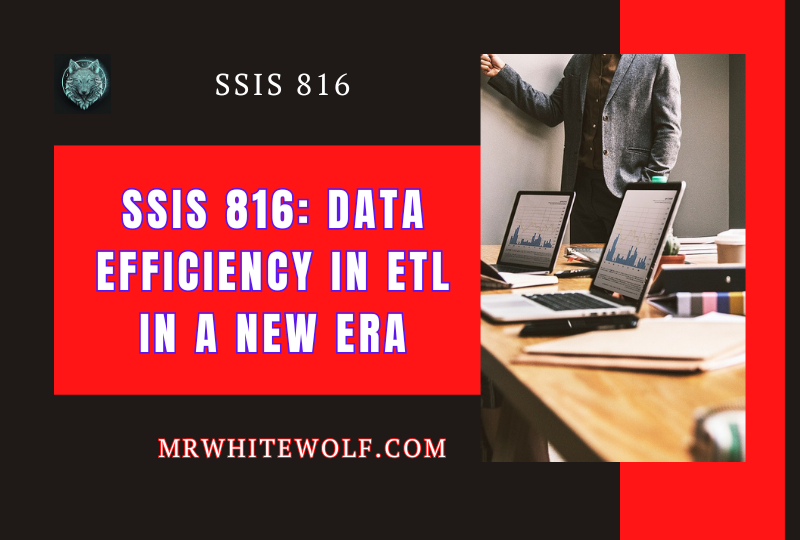FOR SALE
+92-300-1900991
FOR SALE
+92-300-1900991


Microsoft offers a certification exam called SSIS 816 to assess your proficiency in developing and implementing SQL Server Integration Services (SSIS) projects. SSIS serves as a foundation for developing enterprise-level data transformation and integration programs.
SSIS Exam 816 tests your knowledge of SSIS tools and components, such as monitoring flows, data flows, variables, settings, configurations, logging, and deployment models. To pass this exam, you’ll need hands-on experience creating, implementing, and managing SSIS solutions.
Design and implementation of ETL packages
Use built-in transformations such as aggregation, sorting, search up, fuzzy search, etc.
Deploying Tasks and Script Components
Configuring batch and project-level settings
Choose a deployment model (package or project) based on your needs
Manage security by setting the package security level and using roles
A fantastic option to demonstrate your ability to develop dependable SSIS data integration solutions is to earn the SSIS 816 certification. Having this degree will help you differentiate yourself from the competition and demonstrate your abilities to prospective employers. To guarantee that you are knowledgeable about this tool before you get certified, the test covers every facet of SSIS.
Do you feel up to the task? If yes, get ready for your SSIS 816 certification by honing your SSIS skills and taking the test!
Read More: Progressive Renters Insurance Review (2024)

SSIS is a reliable tool that you should always have on hand when it comes to ETL, or ETL (Data Extraction, Transformation, and Loading). Significant improvements have been made to ETL process management with the release of SQL Server 2016 and the introduction of SSIS scale-out, also known as SSIS 816, for data scientists used to the conventional technique of executing SSIS packages on a single server. This revolutionary addition not only changes everything, but also provides a scalable and efficient solution to the problems created by dealing with large amounts of data.
Scaling out SSIS can make ETL procedures more scalable, and SSIS packets can run in parallel on multiple servers. For companies that work with huge amounts of data, this feature guarantees optimized speed and faster data processing. When it comes to processing complex ETL operations, SSIS’s distributed scale-out makes it more efficient and reliable, increasing efficiency and agility in an ever-changing world of data integration.
Scaling SSIS out allows you to overcome the conventional constraints of operating on a single server, which leads to a more effective use of resources and a shorter processing time. This technology is invaluable in the fast-paced data world of today, when every second counts to obtain a competitive advantage. A new era of scalability and efficiency of ETL operations began with the horizontal scaling of SSIS, an important tool for data scientists as organizations deal with ever-larger data sets.
The capabilities of SQL Server Integration Services have been significantly expanded with the release of SSIS 816. In the past, managing large amounts of data was difficult because SSIS packets could only run on a single server. This issue was addressed with the introduction of scaling in SSIS 816. Many servers are used to distribute the execution load.
Improving the efficiency, throughput, and durability of ETL (extract, transform, load) processes is the primary goal of SSIS 816. Data scientists can integrate data faster and more reliably by leveraging the power of multiple machines, significantly improving workflow productivity.
Large data sets that were previously considered unmanageable on a single server can now be processed efficiently with this revolutionary feature. Users can optimize their ETL routines by leveraging the compute power of multiple scalable servers in SSIS 816 at the same time.
This enhancement not only improves scalability and performance, but also makes it easier to perform complex data integration operations with ease. By efficiently distributing workloads, SSIS 816 improves the overall efficiency of SQL Server Integration Services and helps organizations achieve faster and more reliable results in their data operations.
Upgrading from a SQL Server Integration Services (SSIS) environment to SSIS 816 offers a number of advantages over previous versions.
One of the biggest benefits is increased security. SSIS 816 includes new features such as Always Encrypted, which helps protect sensitive data, and Integration Runtime, which provides isolated environments for packet execution. Always Encrypted enables column-level data encryption, ensuring that data remains encrypted in memory and in transit. The Integration Runtime creates isolated environments for package execution and restricts access to packages and sensitive data.
Read More: Cookies Gift Baskets
The improved performance is another important benefit of SSIS 816.A multi-node, scale-out architecture is used to provide high availability and higher throughput. You may access data from Azure Blob storage and Hadoop using the new PolyBase functionality, which will speed up the loading of data from both sources.
Moreover, SSIS 816 provides improved performance. The recently introduced Azure SSIS Integration Runtime offers a fully managed solution for SSIS package execution in the cloud. This removes the requirement for on-premises servers and streamlines management. With the inclusion of SSIS projects in Visual Studio 2019, you can now develop and implement SSIS packages within your application.
As a result, SSIS 816 has several benefits over earlier iterations, including as enhanced security, enhanced functionality, and support for cutting-edge technology. You can make sure you have a dependable, secure, and potent data integration platform by updating to the most recent version.
With SSIS 816, take a tour into the ever-changing world of data integration, where issues become opportunities for learning and answers lead to practical applications.
In this study, we explore the capabilities, typical hazards, and intricate functioning of SSIS 816, a powerful tool intended for ETL tasks.
Join us as we delve deeper into the subtleties of performance tweaking, deployment tactics, and debugging, and see how SSIS 816 transforms obstacles into chances for development and advancement.
Problem: Users frequently get into trouble debugging SSIS 816 because they are engrossed in its complicated universe.
When runtime mistakes occur, the tool’s propensity to only deliver partial information poses a challenge and deprives users of information.
Solution: Users can utilize the Breakpoints beacon and data viewers to help them navigate this maze of debugging more easily.
These tools act as a roadmap, offering a thorough overview of defects and transforming an intimidating diagnostic work into a more navigable journey.
Problem: The environment is frequently too complex for customers to handle when they start implementing SSIS 816, mostly because of insufficient package management techniques.
Maintaining a seamless workflow may become problematic if this region is navigated without the right direction.
Adopting a project delivery model, a tactical guide that optimizes workflows, is the answer.
This paradigm presents the use of parameters and makes the job of shared connection managers—which serve as guides for shared navigation—easier.
This may also remove the need for manual setup after deployment, in addition to streamlining the deployment process.
Performance Tuning Testing Difficulty: SSIS 816 presents a difficulty in its quest for peak performance.
There is a risk of resource depletion and inefficiencies in ETL processes.
Users might select the optimization path as a solution to this issue.
Features like row tuning and pipeline buffer sizing become important tools, like expert craftsmen refining the performance canvas.
Furthermore, using the rapid start options included in the OLE DB target component manages to greatly reduce load times without sacrificing data quality, making it a performance maestro.
As you conquer these difficulties, keep in mind that each one serves as a springboard, a chance to learn more, and an indication that methodical solutions are needed.
In the end, this procedure makes SSIS 816 more usable overall and transforms problems into advancement markers!
SSIS 816 is an effective technique for managing and integrating data. Improving data operations requires an integrated approach to complicated data integration scenarios. We’re enhancing SSIS 816’s standing as the top data integration solution as we get more understanding of its intricacies and how it transforms data into insights.
What are the advantages of SSIS 816 in terms of performance, scalability, and affordability?
Compared to SSIS 816, it is more powerful, scalable, and efficient. In a contemporary, data-intensive application, cross-server ETL approaches are more effective. Because of these advantages, businesses wishing to fortify their data infrastructure will find the SSI 816 invaluable.
What is SSIS 816, please?
The 2016 upgrade for SQL Server Integration Services (SSIS) was ASSIS 816.Data integration, transformation, and management are made easier by a number of new features and improvements.
How does SSIS 816 bring new features and streamline procedures with data integration?
It’s now simpler to include SSI 816 into your data processing procedures thanks to new Microsoft capabilities. The newest edition’s new features and enhanced ETL methods satisfy the ever-evolving demand for data. The SSI 816 is now more suited to the data environments of today because to these improvements.
What are the advantages that users receive from incremental package provisioning?
Users can deploy individual packages individually via incremental package provisioning, which expedites the update process. Package administration is made easier, development flexibility is increased, and upgrade downtime is decreased using this functionality.
How well does SSIS 816 handle Always On Availability Groups (AOAGs)?
By integrating SSIS with Always On SQL Server, AOAG support offers high availability. For companies that need constant data availability and little downtime, this is essential.
What enhancements are included in SSIS 816’s SSIS catalog?
The SSIS Catalog has been improved by SSIS 816, which also has improved logging, reporting, and monitoring features. This makes troubleshooting and optimization simpler and provides administrators with a more comprehensive view of package execution.
How are Azure services integrated with SSIS 816?
Improved connectivity with Azure services is one of SSIS 816’s features, which enables customers to expand their ETL processes to the cloud. This makes it possible to integrate Azure Data Factory and other cloud solutions seamlessly.
What is SSIS 816’s support for Power Query?
Users can now directly utilize Power Query transformations within SSIS data flows thanks to native support for Power Query as a source included in SSIS 816. This improves the robustness and flexibility of data manipulations.
[…] Read More: What are SSIS 816 services? […]
[…] Read More: What are SSIS 816 services? […]